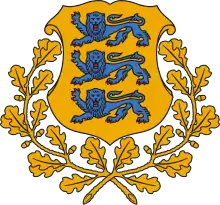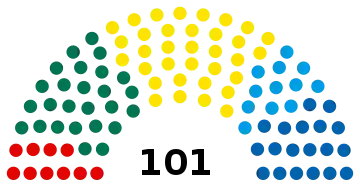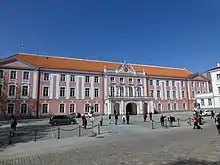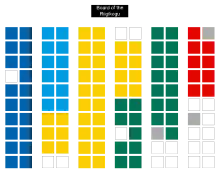Riigikogu
The Riigikogu (Estonian pronunciation: [ˈriːɡikoɡu]; from riigi-, of the state, and kogu, assembly) is the unicameral parliament of Estonia. All important state-related questions pass through the Riigikogu. In addition to approving legislation, the Riigikogu appoints high officials, including the Prime Minister and Chief Justice of the Supreme Court, and elects (either alone or, if necessary, together with representatives of local government within a broader electoral college) the President. The Riigikogu also ratifies significant foreign treaties that impose military and proprietary obligations, bring about changes in the law, etc.; approves the budget presented by the government as law and monitors the executive power.
State Assembly of Estonia Riigikogu | |
|---|---|
| XIV Riigikogu | |
 | |
| Type | |
| Type | |
| History | |
| Founded | 23 April 1919 |
| Disbanded | 1940–1991 |
| Leadership | |
President | Jüri Ratas, Centre since 18 March 2021 |
First Vice-President | Helir-Valdor Seeder, Isamaa since 19 July 2022 |
Second Vice-President | Martin Helme, EKRE since 18 March 2021 |
| Structure | |
| Seats | 101 |
.svg.png.webp) | |
Political groups | Government (55)
Opposition (46)
|
| Committees | 11 Committees
|
| Elections | |
| Party-list proportional representation Modified D'Hondt method | |
Last election | 3 March 2019 |
Next election | 5 March 2023 |
| Meeting place | |
.jpg.webp) | |
| Toompea Castle, Tallinn | |
| Website | |
| www.riigikogu.ee | |
| Footnotes | |
Unaffiliated MP Raimond Kaljulaid votes with SDE, Anastassia Kovalenko-Kõlvart votes with Centre, Martin Repinski left Centre. Mihhail Stalnuhhin was expelled from Centre on September 6 2022[1]. | |
History
Politics of Estonia |
|---|
 |
|
History
April 23, 1919, the opening session of the Estonian Constituent Assembly is the birthday of the Estonian Parliament.[2] Established under the 1920 constitution, the Riigikogu had 100 members elected for a three year term on the basis of proportional representation. Elections were fixed for the first Sunday in May of the third year of parliament.[3] The first elections to the Riigikogu took place in 1920. From 1923 to 1932, there were four more elections to the Riigikogu. The elections were on a regional basis, without any threshold in the first two elections, but from 1926 a moderate threshold (2%) was used. The sessions of the Riigikogu take place in the Toompea Castle, where a new building in an unusual Expressionist style was erected in the former courtyard of the medieval castle in 1920–1922.
In 1933 amendments to the first Constitution was approved by referendum, where more power was given to an executive President. The following year the President used these new powers to adjourn parliament and declared martial law to avert an alleged coup.[4] In 1937 a second constitution was approved by referendum which saw the introduction of a two chambered legislature, the Chamber of Deputies (Riigivolikogu) and the National Council (Riiginõukogu). Elections were subsequently held in 1938 with only one party and non-affiliated individual candidates were allowed to run.
During the subsequent periods of Soviet occupation (1940–41), German occupation (1941–44), and the second Soviet occupation (1944–1991) the Riigikogu was disbanded. The castle and the building of the Riigikogu were used by the Supreme Soviet of the Estonian SSR during the second Soviet occupation.
Restitution of independence
In September 1992, a year after Estonia had regained its independence from the Soviet Union, elections to the Riigikogu took place on the basis of the third Constitution of Estonia adopted in the summer of the same year. The 1992 constitution, which incorporates elements of the 1920 and 1938 Constitutions and explicitly asserts its continuity with the Estonian state as it existed between 1920 and 1940, sees the return of a unicameral Riigikogu with 101 members. The present Riigikogu was elected on March 3, 2019. The main differences between this system and a pure political representation, or proportional representation, system are the established 5% national threshold, and the use of a modified D'Hondt formula (the divisor is raised to the power 0.9). This modification makes for more disproportionality than does the usual form of the formula.
Latest election
 | |||||
|---|---|---|---|---|---|
| Party | Votes | % | Seats | +/– | |
| Estonian Reform Party | 162,363 | 28.93 | 34 | +4 | |
| Estonian Centre Party | 129,618 | 23.10 | 26 | −1 | |
| Conservative People's Party of Estonia | 99,671 | 17.76 | 19 | +12 | |
| Isamaa | 64,219 | 11.44 | 12 | −2 | |
| Social Democratic Party | 55,175 | 9.83 | 10 | −5 | |
| Estonia 200 | 24,448 | 4.36 | 0 | New | |
| Estonian Greens | 10,227 | 1.82 | 0 | 0 | |
| Estonian Biodiversity Party | 6,858 | 1.22 | 0 | New | |
| Estonian Free Party | 6,461 | 1.15 | 0 | −8 | |
| Estonian United Left Party | 511 | 0.09 | 0 | 0 | |
| Independents | 1,590 | 0.28 | 0 | 0 | |
| Total | 561,141 | 100.00 | 101 | 0 | |
| Valid votes | 561,141 | 99.31 | |||
| Invalid/blank votes | 3,904 | 0.69 | |||
| Total votes | 565,045 | 100.00 | |||
| Registered voters/turnout | 887,420 | 63.67 | |||
| Source: Valimised | |||||
Current seat allocation


- Reform Party 34
- party leader: Kaja Kallas
- Centre Party 23
- party leader: Jüri Ratas
- Conservative People's Party of Estonia 19
- party leader: Martin Helme
- Isamaa 11
- party leader: Helir-Valdor Seeder
- Social Democratic Party of Estonia 9
- party leader: Lauri Läänemets
- Unaffiliated 5
- Raimond Kaljulaid (since 5 April 2019 / K before)
- Martin Repinski (since 21 March 2022 / K before)
- Anastassia Kovalenko-Kõlvart (since 4 April 2022 / replaces SDE-MP)
- Siim Kiisler (since 18 August 2022 / replaces I-MP)
- Mihhail Stalnuhhin (since 6 September 2022 / K before, expelled)
Structure of former legislatures
Estonian Parliament 1992–1995
| 29 | 17 | 15 | 12 | 10 | 8 | 8 | 1 | 1 |
| Isamaa | Safe Home | Popular Front | Moderates | Independence | ERP | Citizen | Greens | EEE |
Estonian Parliament 1995–1999
| 41 | 19 | 16 | 8 | 6 | 6 | 5 |
| Coalition/Country | Reform | Centre | RKEI and ERSP | Moderates | Home | Right |
Estonian Parliament 1999–2003
| 28 | 18 | 18 | 17 | 7 | 7 | 6 |
| Centre | Pro Patria | Reform | Moderates | Coalition | Country | United |
Estonian Parliament 2003–2007
| 28 | 28 | 19 | 13 | 7 | 6 |
| Kesk | Res Publica | Reform | People's Union | Pro Patria | Moderates |
Estonian Parliament 2007–2011
| 31 | 29 | 19 | 10 | 6 | 6 |
| Reform | Centre | IRL | SDE | Greens | People's Union |
Estonian Parliament 2011–2015
| 33 | 26 | 23 | 19 |
| Reform | Centre | IRL | SDE |
Estonian Parliament 2015–2019
| 30 | 27 | 15 | 14 | 8 | 7 |
| Reform | Centre | SDE | IRL | EVA | EKRE |
Estonian Parliament 2019–present
| 34 | 26 | 19 | 12 | 10 |
| Reform | Centre | EKRE | Isamaa | SDE |
Speakers of the Riigikogu
The salary of the speaker is €5,288 per month.[5]
1921–1937
| Name | Period | Legislature |
|---|---|---|
| Otto Strandman | January 4, 1921 – November 18, 1921 | I Riigikogu[6] |
| Juhan Kukk | November 18, 1921 – November 20, 1922 | I Riigikogu[6] |
| Konstantin Päts | November 20, 1922 – June 7, 1923 | I Riigikogu[6] |
| Jaan Tõnisson | June 7, 1923 – May 27, 1925 | II Riigikogu[6] |
| August Rei | June 9, 1925 – June 22, 1926 | II Riigikogu[6] |
| Karl Einbund | June 22, 1926 – July 19, 1932 | III Riigikogu, IV Riigikogu, V Riigikogu[6] |
| Jaan Tõnisson | July 19, 1932 – May 18, 1933 | V Riigikogu[6] |
| Karl Einbund | May 18, 1933 – August 29, 1934 | V Riigikogu[6] |
| Rudolf Penno | September 28, 1934 – December 31, 1937 | V Riigikogu[6] |
Speakers of the Riigivolikogu (lower chamber)
| Name | Period | Legislature |
|---|---|---|
| Jüri Uluots | April 21, 1938 – October 12, 1939 | VI Riigikogu[6] |
| Otto Pukk | October 17, 1939 – July 5, 1940 | VI Riigikogu[6] |
| Arnold Veimer | July 21, 1940 – August 25, 1940 |
Speaker of the Riiginõukogu (upper chamber)
| Name | Period | Legislature |
|---|---|---|
| Mihkel Pung | April 21, 1938 – July 5, 1940 | VI Riigikogu[6] |
Chairman of the Supreme Council (1990–1992)
| Name | Period |
|---|---|
| Arnold Rüütel | March 29, 1990 – October 5, 1992 |
Speaker of the Supreme Council (1990–1992)
| Name | Period |
|---|---|
| Ülo Nugis | March 29, 1990 – October 5, 1992 |
Since 1992
| Name | Period | Legislature |
|---|---|---|
| Ülo Nugis | October 21, 1992 – March 21, 1995 | VII Riigikogu[6] |
| Toomas Savi | March 21, 1995 – March 31, 2003 | VIII Riigikogu, IX Riigikogu[6] |
| Ene Ergma | March 31, 2003 – March 23, 2006 | X Riigikogu[6] |
| Toomas Varek | March 23, 2006 – April 2, 2007 | X Riigikogu[6] |
| Ene Ergma | April 2, 2007 – March 20, 2014 | XI Riigikogu, XII Riigikogu[6] |
| Eiki Nestor | March 20, 2014 – April 4, 2019 | XII Riigikogu, XIII Riigikogu[6] |
| Henn Põlluaas | April 4, 2019 – March 18, 2021 | XIV Riigikogu[6] |
| Jüri Ratas | March 18, 2021 | XIV Riigikogu[6] |
Chancellery
The Chancellery of the Riigikogu (Estonian: Riigikogu Kantselei) is the administration supporting the Riigikogu in the performance of its constitutional functions.[7]
See also
- List of members of the Parliament of Estonia
- Chairman of the Supreme Soviet of the Estonian Soviet Socialist Republic
Citations and references
- Krjukov, Aleksander (6 September 2022). "Keskerakonna juhatus heitis Mihhail Stalnuhhini erakonnast välja" (in Estonian). ERR. Retrieved 6 September 2022.
- "Riigikogu". Riigikogu.
- Miljan 2004, p. 413.
- Miljan 2004, p. 414.
- "Riigikogu liikmete ja teiste kõrgemate riigiteenijate palk ei muutu". Postimees. 15 March 2017.
- "Riigikogu juhatus". Riigikogu.
- "Chancellery of the Riigikogu". Riigikogu (in Estonian). Retrieved 21 March 2020.
Cited sources
- Miljan, Toivo (2004). Historical Dictionary of Estonia. Maryland, USA: Scarecrow Press. ISBN 0-8108-4904-6.
External links
- Official website

- Riigkogu's election law (in English)
